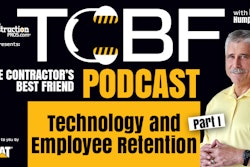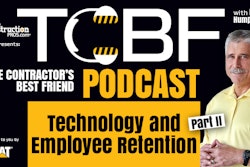Editor's Note: This is the first installment of a two-part article. The conclusion of this article will be published in mid-July. Check back to Employee Matters section of ForConstructionPros.com to read the rest of this article.
Recently graduated from a top engineering program, Robert had a career on the rise within a large, international specialty-contracting firm. This bright young man successfully completed the company's three-year project manager training program and had become one of their most reliable and promising employees.
He was rewarded with the responsibility of managing and coordinating multi-million dollar projects and everyone expected Robert to be the firm's next superstar. So when Robert suddenly resigned his position to return to his home in the Midwest, his decision shocked his coworkers, including his manager. Ironically, if the firm had known about Robert's interest in changing locations, the company could have considered relocation. Somehow, communication had failed and the firm felt the sting of losing a project manager who was expected to play an important role in the growth of the company.
Like Robert, many good employees leave businesses bewildered - wondering what went wrong. But companies don't have to wait for employees to make the next move. By taking a proactive approach to developing an effective employee retention program, the anxiety of high turnover can be reduced. True, employee retention takes time, effort and resources, but the rewards can prove valuable.
The Importance of Retention
Retaining good employees is critical to a business' long-term success. And in the engineering and construction markets, employee retention is especially serious since the job market is tight and competition is fierce for top candidates. When you add the costs of recruiting and training employees, the financial impact alone is staggering. Some studies estimate that losing an employee costs a company 100 percent of that employee's salary. When reduced efficiency, lower effectiveness, workforce instability and lost productivity are added to the cost to find and train a new employee, the stakes become high. A company simply cannot afford to ignore employee retention.
Yet many well-meaning companies fail to invest in retention. The architecture/engineering/construction (A/E/C) industry is fast-paced, and businesses are scrambling in the day-to-day activities of bidding, estimating and managing projects. Making a commitment to retention seems like an impossible task when managers' plates are already full. But when businesses consider the long-term value of committing to employee retention, the effort is well worth the investment of time and resources.
One of the major drivers for investing in a retention program is the financial impact of recruiting and training valued employees. No less important is the effect on co-workers. When people leave a business, morale can be deeply impacted. Other employees may become fearful and uncertain about their status within the company. Such apprehension and insecurity can spread like a virus, and soon turnover may seem uncontrollable. High turnover also can give a business an unhealthy reputation in the marketplace, making recruiting future candidates especially difficult. To avoid these pitfalls and to keep moving toward success, companies must be willing to devote time, money and resources to understanding and implementing diverse employee retention strategies.
Effective Strategies for Retention
Understanding what motivates a person to look for another position is an important step. In creating an effective retention program, compensation and benefits are certainly factors in a person's job satisfaction, but a caring workplace where employees feel valued is critical. Companies have found that the reason employees look is not always the reason they leave. Why do some businesses do a better job of retaining employees than others? Keeping employees for the long term doesn't happen magically or by good luck. Rather, businesses must make a conscious effort toward employee development. The key lies in the planning. Companies that establish a clear, definitive strategy for retention will benefit tremendously. Below are some strategies that are invaluable in a retention program.
Culture and Commitment: It is a common misconception that retention is the sole responsibility of a company's Human Resources (HR) Department. In practice, a successful program includes buy-in from all departments and levels of an organization. Owners, top executives and managers must jointly establish company operating principles that define its value system. Further, these leaders must take an active role in promoting, communicating and practicing this culture. A strong company culture is one that places value on people, fosters teamwork, is forward thinking and encourages open communication.
Additionally, it is important to point out that employees typically don't leave companies. Rather, they leave managers. A poor relationship with a manager is one of the primary reasons people become dissatisfied. One solution is periodic leadership training and retraining directly taught by company leaders. These sessions can help all employees re-connect with the company's values and mission. Additionally, allowing employees to attend conferences and professional development seminars validates a keen interest in an employee's professional development -- strengthening not only the individual's commitment to the company, but also the message that the business cares about the long-term success of all employees.
Integration
Welcoming an employee into your company may seem like an easy task, but many organizations fail to plan accordingly. Understand that integration must begin before the employee's first day of work. While a new job can be exciting, it also comes with feelings of fear and vulnerability, not to mention the stress of fitting in, meeting new people, and learning new processes. An individual's first impression can be lasting, so it is critical for companies to take a proactive approach toward easing their transition.
Begin with a welcome letter from a direct supervisor, the owner or other recognized leader. The letter should share the company's vision, culture and outlook for the future, and it also should reaffirm the company's excitement about the hire. Also, it is ideal to have the employee's work space furnished, business cards and name tag ordered, office supplies stocked, and any other required tools ready for the first day of work. What better way to prove your company's enthusiasm to your new colleague? When the new employee arrives, make it someone's job to greet and welcome him or her. Provide introductions to existing employees and schedule lunches with a variety of people.
Having a buddy system or assigning a mentor to each new employee also is very helpful for easing tension or feelings of nervousness. Ideally, the mentor is someone who recently held the same position. Typically, new employees have numerous questions - some big and many small, and the mentor becomes a person the employee can confide in, offering support and information needed for a smooth transition.
An orientation program should not conclude after a series of PowerPoint presentations and paperwork on the first day. A truly effective orientation program is one that demonstrates a long-term commitment toward employee development. Many businesses have formal training programs that last several weeks to several years. Training programs vary in nature; but typically in the A/E/C industry, training programs are very job specific.
In other industries, Fortune 100 companies have experimented with methods that educate employees about all aspects of a business. For example, many accounting businesses and financial institutions provide training programs that allow new employees to work at every level of the company - from teller to assistant manager -- for their first two years before they can assume a management position. This broad experience gives employees an understanding of the challenges faced in a variety of roles and provides a clear picture of department interaction.
The A/E/C industry is learning from the successes of these broad-based training programs. Some savvy businesses have initiated training programs that rotate new employees throughout numerous company divisions, such as project management, estimating, business development, manufacturing, branch operations, detailing/project coordination and engineering/design.
Whether job-specific or broad in scope, training programs do more than teach processes and procedures. They promote teamwork, allow employees to build relationships, increase employee support channels, illustrate potential career paths and broaden the individual's knowledge of the company and industry - ultimately helping employees feel valued and connected to the organization.
Beyond welcome letters, mentors and training, it is also vitally important that goals be established for the employee within the first few months of employment. A manager should understand as early as possible what the employee wants to achieve in the short and long term and begin establishing measurable objectives to reach those goals.
About Structural Group
As one of the nation's leading specialty contractors, Structural Group is comprised of three dynamic and diversified companies. Structural Preservation Systems is the largest specialty contractor focusing on structural repair and strengthening. VSL is the technical leader in post-tensioning and specialty reinforcement. And, Pullman Power leads the industry in chimney, silo and stack construction, maintenance, and repair. From 25 operating centers around the United States, Structural Group businesses perform a wide range of projects involving industrial facilities, commercial properties, public infrastructure and municipal buildings. For more information about Structural Group, visit www.structural.net



















